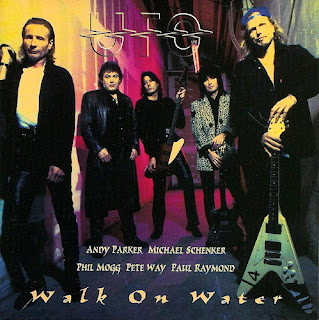Walk On Water
UFO
Released 1995
Good luck finding it
on Amazon Marketplace or eBay!
I discovered Walk On
Water a few months ago after cruising Youtube for UFO videos. The first
studio album with Michael Schenker on guitar since 1978 eluded me when it was
first released. That’s probably because Nine Inch Nails and alt-rock were my
chosen musical milieu at the time. Had someone told me UFO and Schenker were
back together, I would have dismissed the information with “Are those guys
still around?” Ahh, the follies of youth.
Now wiser and more open minded, I decided to listen to the
album. I wasn’t expecting much, because the facts didn’t sound promising. A 1970s
hard rock band’s classic line-up reassembles 17 years later, reuniting
guitarist and singer who hated each other; the musical climate
has changed, leaving hard rock forgotten by the mainstream; you’re older, they’re
older, and so on and so on. It seemed like a set up for disappointment.
Boy, was I wrong! You know what happens when you assume. Walk On Water is a fitting follow-up to Obsession,
the last Schenker-era studio album. Produced by Ron Nevison, who helmed Lights Out, Strangers in the Night and Obsession, this album packs a wallop. The
classic‘70s lineup is here - Schenker,
Mogg, Way, Raymond and Parker. They all hung around for a few years of touring
except Parker, who was replaced by Simon Wright for live shows.
Schenker’s guitar playing on Walk on Water is as mesmerizing as ever, reeling you in from the first
crunchy riff on the album opener, “Self-Made Man”. It’s like time stood
still. The song is an indictment of greedy businessmen, with fierce vocals to match on the
verses, and a softer, meditative chorus. This song has some of Mogg’s best
lyrics and it’s become one of my favorite UFO songs. “Venus” is an ode to the
ups and downs of love, with a pristine, melodic solo from Schenker.
The songs deal with more grown-up concerns, as the band
members were around mid-life crisis age in 1995. “Pushed to the Limit” rages
against the sands of time going through the hourglass “My doctor says it ain't
right/For a man my age to fight”, Mogg proclaims, not ready for the rocking
chair by a long shot. Schenker’s razor-sharp riffs are a perfect complement to
the lyrics. “Running on Empty” covers the same subject matter with a bit of
romance and sexy, bluesy guitar. The evil ex wife in “Knock,Knock” gets the
house and the car and is back for more.
“Dreaming of Summer” is a haunting tale of an unemployed man
watching his life slip away. It’s a
real-life scenario a lot of people can identify with, balanced by Schenker’s
tasteful acoustic guitar. It’s WOW’s “Love
to Love.” Spiritual and uplifting despite the title, “Darker Days” is melodic
rock at its best – once you hear it, it’s hard to get it out of your head.
“Stopped (By a Bullet of Love)” seems to be about picking up
and falling in love with a girl at a bar. What inspired it? Never ask about a song’s backstory, just enjoy
it. You may discover things you’d be better off not knowing. And what’s that bit
about Arizona? Didn’t Schenker
live in Arizona for awhile?
There are new versions of “Doctor Doctor” and “Lights Out”
to end the album, but why try to improve on perfection?
I find myself playing this as much as Obsession or Lights Out. Despite
the album’s quality, I have no interest in listening to the two reunion albums
that followed - the one side live/one side original album Covenant and the all-original Sharks.
The latter sounds a little too Spinal
Tap-ish for my comfort, so I think I’ll quit while I’m ahead.
Twenty years have passed since Walk on Water. The reunion ended in the early ‘00s because, as the
saying goes, insanity is doing the same thing over and over and expecting
different results.
Late 1970s UFO
Everyone’s doing great staying far away from one another as
they enter their (semi) retirement years. Pete Way
beat cancer and he’s working on his solo album, and both Mikey and UFO are touring
non-stop. We have more musical
output and nobody is getting punched in the stomach or storming offstage.
Present-day UFO fares well with Vinnie Moore on guitar, but
that je ne sais quoi (we know who that is)
is missing. The synergy between Mogg, Schenker, Way, Raymond and
Parker was absolutely electric back in the day. Another reunion is unlikely, but
we’ll always have our memories.











